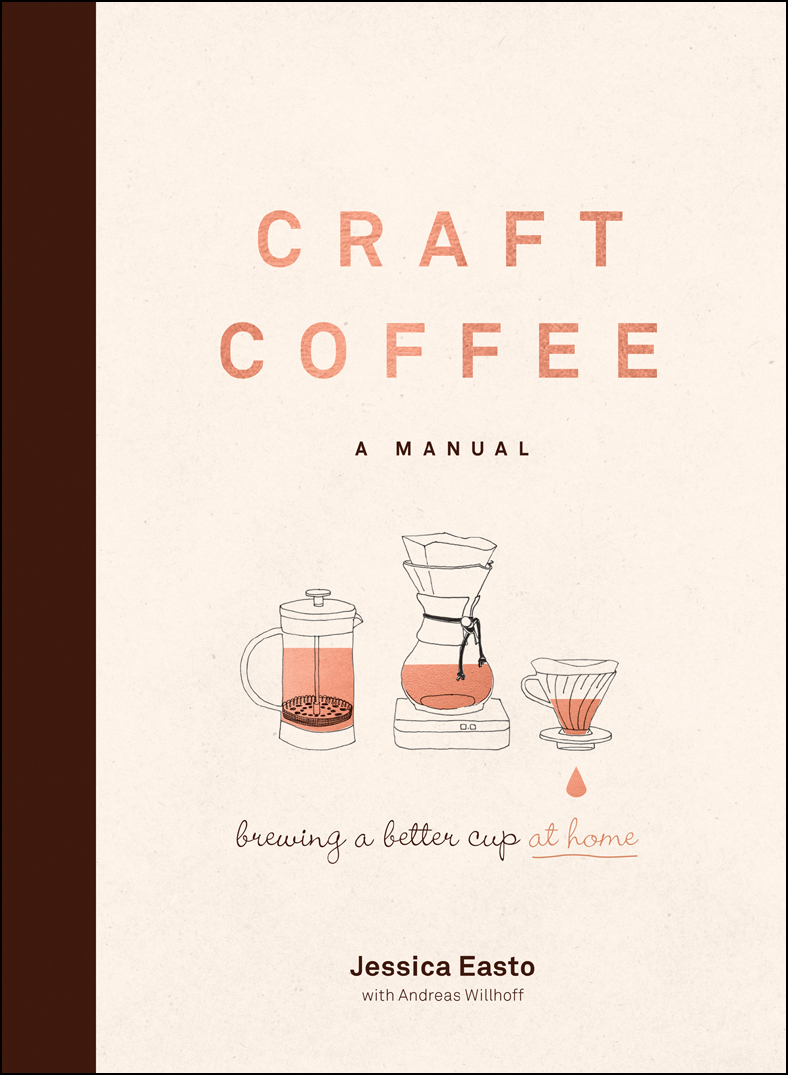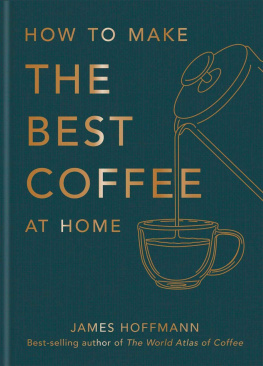Easto Jessica - Craft coffee: a manual: brewing a better cup at home
Here you can read online Easto Jessica - Craft coffee: a manual: brewing a better cup at home full text of the book (entire story) in english for free. Download pdf and epub, get meaning, cover and reviews about this ebook. City: Chicago, year: 2017, publisher: Agate Publishing;Surrey Books, genre: Home and family. Description of the work, (preface) as well as reviews are available. Best literature library LitArk.com created for fans of good reading and offers a wide selection of genres:
Romance novel
Science fiction
Adventure
Detective
Science
History
Home and family
Prose
Art
Politics
Computer
Non-fiction
Religion
Business
Children
Humor
Choose a favorite category and find really read worthwhile books. Enjoy immersion in the world of imagination, feel the emotions of the characters or learn something new for yourself, make an fascinating discovery.

- Book:Craft coffee: a manual: brewing a better cup at home
- Author:
- Publisher:Agate Publishing;Surrey Books
- Genre:
- Year:2017
- City:Chicago
- Rating:4 / 5
- Favourites:Add to favourites
- Your mark:
- 80
- 1
- 2
- 3
- 4
- 5
Craft coffee: a manual: brewing a better cup at home: summary, description and annotation
We offer to read an annotation, description, summary or preface (depends on what the author of the book "Craft coffee: a manual: brewing a better cup at home" wrote himself). If you haven't found the necessary information about the book — write in the comments, we will try to find it.
Craft coffee: a manual: brewing a better cup at home — read online for free the complete book (whole text) full work
Below is the text of the book, divided by pages. System saving the place of the last page read, allows you to conveniently read the book "Craft coffee: a manual: brewing a better cup at home" online for free, without having to search again every time where you left off. Put a bookmark, and you can go to the page where you finished reading at any time.
Font size:
Interval:
Bookmark:



Copyright 2017 by Jessica Easto
Illustrations 2017 by Morgan Krehbiel
No brands, companies, or products mentioned in this book have endorsed the information contained herein.
The pie chart on were adapted from a design by Kamila Krauze for Halfwit Coffee Roasters. Both are used, gratefully, with permission.
Craft Coffee: A Manual
eISBN13: 978-1-57284-804-7
First Edition: November 2017
Surrey Books is an imprint of Agate Publishing.
Agate books are available at bulk and discount prices.
Visit agatepublishing.com for more information.
Contents
Table of Contents
CRAFT COFFEE CAN BE A POLARIZING SUBJECT . In the United States, coffee has had a long history of being made poorly and convenientlyand bought and sold cheaply. For many colonial settlers, coffee was liquid fuel, something that got their gears going in the morning and made them forget, if only for a moment, that they were slowly and murderously humping (European) humanity westward. It wasnt supposed to taste good, and for a while in the 19th century, it couldnt taste good; there were no adequate tools. People would burn coffee beans in a frying pan and then boil them with water (enter sugar and cream). In the later part of the 1800s, manufacturers started making fake coffee from various grains, which people continued to buy, despite being aware of the con, until they realized the additives usually included actual poisons, like arsenic and lead. Later came convenient preground coffee and later still, because ground coffee goes stale quickly, vacuum seals, both of which were, more or less, marketing gimmicks. The expectation that coffee is gross, convenient, and cheap is deeply engrained in the American psyche, and some people get prickly when others start talking about good-tasting, mildly inconvenient, relatively expensive coffee.
Let them prickle. Read this book. Make great coffee.
My coffee journey did not start out as a deliberate quest for the perfect cup. Instead, I found my way to craft coffee via a circuitous road largely paved with ignorance and pragmatism. My parents never drank coffee, and I had little exposure to it growing up. In high school, I ordered my first cup of coffee blackat a local dinerbecause I didnt understand that many people expect coffee to be vile and rely on cream and sugar to help them suffer through it. I accepted the thin, bitter brew without question. I had become a black-coffee drinker. Without the sweet embrace of cream and sugar, it didnt take me long to realize that different coffees have different tastes. I knew that diner coffee was markedly different from Starbucks coffee, and Starbucks coffee was distinct from my local independent cafs coffeebut I never thought to ask why.
I also never lived near a caf that offered manually brewed coffeeI didnt even know such cafs existed or that manual brewing methods had qualitative differences from machines. When I purchased my first pour-over device in graduate school, it was only because a machine seemed extravagant and unnecessary for the single cup I brewed each morning. I figured out how to work it well enough, but only occasionally did I brew significantly better coffee than that diner back in high school did. Then one day my friend Andreas (who is now my husband) came over and saw I had a manual coffeemaker. He happened to be a barista and seeing that I had never invested any time in learning how to use the device properly, he showed me a couple of easy ways to improve my brew. As it turns out, coffeewhen brewed manuallycan be controlled and even manipulated for best results every time. For me, this was a revelation.
By the time Andreas and I moved to Chicago after graduate school, independent roasters and cafs had been thriving for years, and it was easy to sample coffee made with high-quality beans from around the globe and brewed on any of several different devices. This coffee was flavorful, smooth, and fulla far cry from my first black cup.
Most people recognize that diner coffee often leaves much to be desired and turn to chains like Starbucks and Peets for better alternatives. For many people, their first exposure to smooth, flavorful, high-quality coffee takes place at a small independent caf. They then try to make the same coffee at home, but somehow, it never tastes as good as it does at the caf. From there, its hard to know where to turn. The internet, with its depths of overwhelming, conflicting information, can make it difficult for home coffee brewers to learn how to improve. Then there are baristas, who can cause a different kind of hesitation. The coffee world uses a lot of jargon, and as in any new community whose members talk to each other in code, it can be intimidating to approach a professional with questionsespecially in the coffee industry with its unfortunate (although often undeserved) reputation for snobbery.
Today, many baristas are working to change this perception. Still, certain assumptions are often made in the professional coffee realm: this is the way coffee should taste, this is the way to make it, and this is the way to think about it. In reality, there is no one right way for any of it, and insisting that there is doesnt do curious home brewers like us much good. We all appreciate good coffee, but we dont have to appreciate it in the same way.
That being said, some professional brewing tactics may not be a good fit or even necessary for the home kitchen. Because we collectively know relatively little about why coffee does what it does on a scientific level, a lot of misinformation is out thereoften in the form of techniques and practices that have little or no rationale behind themand baristas arent necessarily immune to it.
This book is not written from the perspective of a coffee professional. Its written from my perspective, as a coffee lover and home coffee brewer who has heard it all from the coffee professional who lives with me. I dont make assumptions about your coffee knowledge, budget, or level of fervor. Instead, I realize that coffee enthusiasts exist on a spectrum, and that you will need to (1) figure out where you fall on the spectrum and (2) make coffee decisions that reflect that. This book explores the full body of coffee knowledge and offers guidance, perspective, practical advice, and a healthy dose of my own (informed) opinion to help you make those decisions and develop your own preferences. My goal is to provide you with at least the baseline of knowledge you will need to forge a path toward your own perfect, delicious cup. Take what you want and leave the rest.
This book is organized a bit differently than other coffee books. Chapter 1 contains what I consider to be the most important information when it comes to improving your brew at home: a solid grasp of the science of extraction and the factors that affect it. Understanding why coffee behaves the way it does means that when it comes time to brew, you will know how to troubleshoot less-than-stellar cups and replicate desired results day after day. You can manipulate the fundamentals of brewing coffee depending on what equipment, brewing device, and beans you decide to use, which is why I think you need to read about those fundamentals before you ever pour water over grounds. This is a book about making coffee, after all, and theres no reason to get distracted by how beans grow until you understand the basics of brewing.
Font size:
Interval:
Bookmark:
Similar books «Craft coffee: a manual: brewing a better cup at home»
Look at similar books to Craft coffee: a manual: brewing a better cup at home. We have selected literature similar in name and meaning in the hope of providing readers with more options to find new, interesting, not yet read works.
Discussion, reviews of the book Craft coffee: a manual: brewing a better cup at home and just readers' own opinions. Leave your comments, write what you think about the work, its meaning or the main characters. Specify what exactly you liked and what you didn't like, and why you think so.







